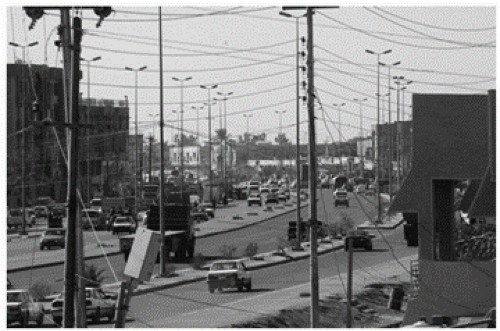Medical Support to Military Operations on Urban Terrain
Frank L. Christopher
OBJECTIVES (Fig 7.1)
After reading this section, the reader will be able to:
Describe the unique challenges presented by MOUT operations.
Discuss strategies to mitigate those challenges.
HISTORICAL PERSPECTIVE
The population of the world is constantly evolving. Since the close of World War II (WWII, the percentage of the Earth’s population that lives in urban areas has almost doubled from 28% in 1945 to 49% today. The trend of migration continues; by 2025, an estimated 58% will live in cities. Today, 1.5 billion people live in 887 different cities with a population of over 1 million each (1).
A continual rise in the number and concentration of urban areas, together with a stretching of infrastructure, limited resources, and unsteady economic bases has led, and will continue to lead, to a parallel increase in the number of armed conflicts occurring within densely populated areas (2). Although limited urban operations were conducted in WWII, Korea, and Vietnam, more recent events, most notably the invasions of Grenada and Panama, the 1993 actions in Mogadishu, and the latest actions in support of the global war on terrorism, have revolved largely around cities. In the United States, the vast majority of firearm homicides occur in urban areas, a statistic with significant tactical law enforcement implications (3).
Available literature on medical support to military operations in urban terrain (MOUT) is scant; a good overview was authored in 1999 by Colonel (later Major General) Lester Martinez-Lopez as an appendix to the Arroyo Center’s working group report on urban operations (4). The landmark article by Butler, et al. in Military Medicine in 2000 (5, 6 and 7) utilizes the Battle of Mogadishu as a framework for discussion of many specific aspects of providing care in an asymmetric urban environment and is a mustread for anyone planning to provide medical support to combat or SWAT operations in built-up areas. The Center for Army Lessons Learned has an extensive online library of publications covering all aspects of MOUT operations available to Department of Defense personnel at https://call2.army.mil/focus/urban-ops.index.asp.
MOUT CHALLENGES
The Joint Staff’s Handbook for Joint Urban Operations describes the typical urban environment as “a concentration of structures, facilities, and population and is the economic, political, and cultural focus of the surrounding area” (8). The individuals charged with constructing the medical support template for any urban operation must take each of these considerations into account while developing the tactical plan.
Training and Rehearsal
The key to success in providing medical support to MOUT operations is to ensure that everyone on the target is trained, rehearsed, and ready to react to any casualty producing situation. This may represent a significant shift in current training philosophies; classically, “shooters” shoot and medics treat the wounded. However, in close quarters battle, lives and success depend upon each individual becoming cross-trained. The 75th Ranger Regiment, based on lessons learned from urban operations in Somalia, maintain the training philosophy that for team success on the MOUT battlefield each ranger needs to be proficient in four areas: physical fitness, marksmanship, battle drills, and medical proficiency (9). Using the ranger paradigm, which has subsequently been adopted by multiple army
and marine light units, every soldier entering the objective is trained to provide basic lifesaving care, usually by completion of the Tactical Combat Casualty Care curriculum (10), which emphasizes three tenets: care under fire, tactical field care, and combat casualty evacuation care and is designed to prevent preventable death on the battlefield. This model is discussed elsewhere in this text. Additionally, every squad or section has at least one EMT-basic; every platoon includes at least one school-trained field medical professional.
and marine light units, every soldier entering the objective is trained to provide basic lifesaving care, usually by completion of the Tactical Combat Casualty Care curriculum (10), which emphasizes three tenets: care under fire, tactical field care, and combat casualty evacuation care and is designed to prevent preventable death on the battlefield. This model is discussed elsewhere in this text. Additionally, every squad or section has at least one EMT-basic; every platoon includes at least one school-trained field medical professional.
 FIGURE 7.1. MOUT operations present unique challenges. (Courtesy of the 82D Airborne Division Public Affairs Office.) |
Integrating casualty “play” into every training scenario and exercise well before starting actual combat operations will dramatically improve reaction, intervention, and survival. The utilization of “notional” casualties or casualty cards is insufficient to provide realistic training; specific individuals should be prompted to become “wounded” and the remainder of the team must then react, treat, evacuate, and be critiqued. Personnel should also rehearse what to do when the far-forward medic is the casualty. Alternatively, moulaged patients or computerized human patient simulators can be utilized as real-time training tools for first responders and medical personnel alike. Immediate treatment and evacuation of casualties off of the immediate objective without decrementing the fighting force must become a battle drill for all units conducting MOUT training exercises.
Treatment Capability and Location
Selecting a site as an initial casualty collection, triage, and evacuation point presents a significant challenge in the asymmetric MOUT environment. Ideally, this position will be free from the known enemy; be within casualty-carrying distance of the objective; be able to be secured; not be in the vicinity of friendly predesignated indirect fire targets; facilitate communication; provide cover, concealment, and weather protection; support lighting, suction, monitoring, or other specific treatment requirements; have at least two secure ground ingress and egress routes; and have the capability to safely accommodate a rotary-wing evacuation platform. Finding such an ideal site in the urban environment is frequently impossible and selecting the best location will require significant interaction with the intelligence, terrain analysis, and tactical leadership.
Stay updated, free articles. Join our Telegram channel

Full access? Get Clinical Tree






